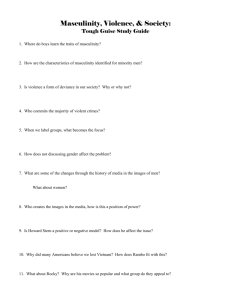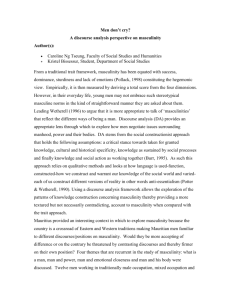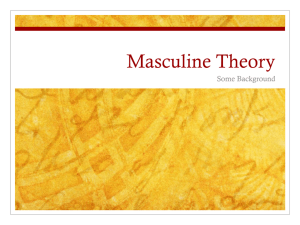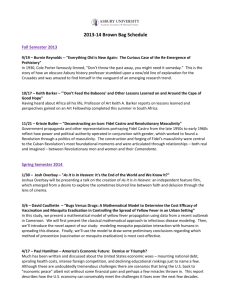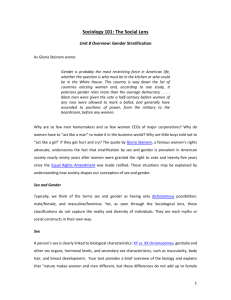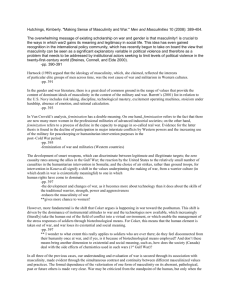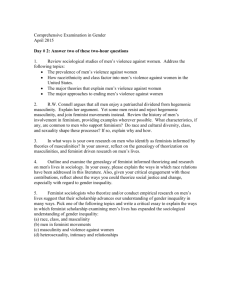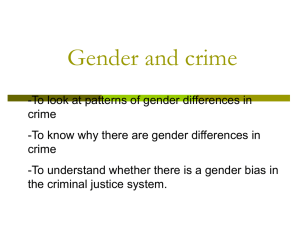- Michael Messner
advertisement
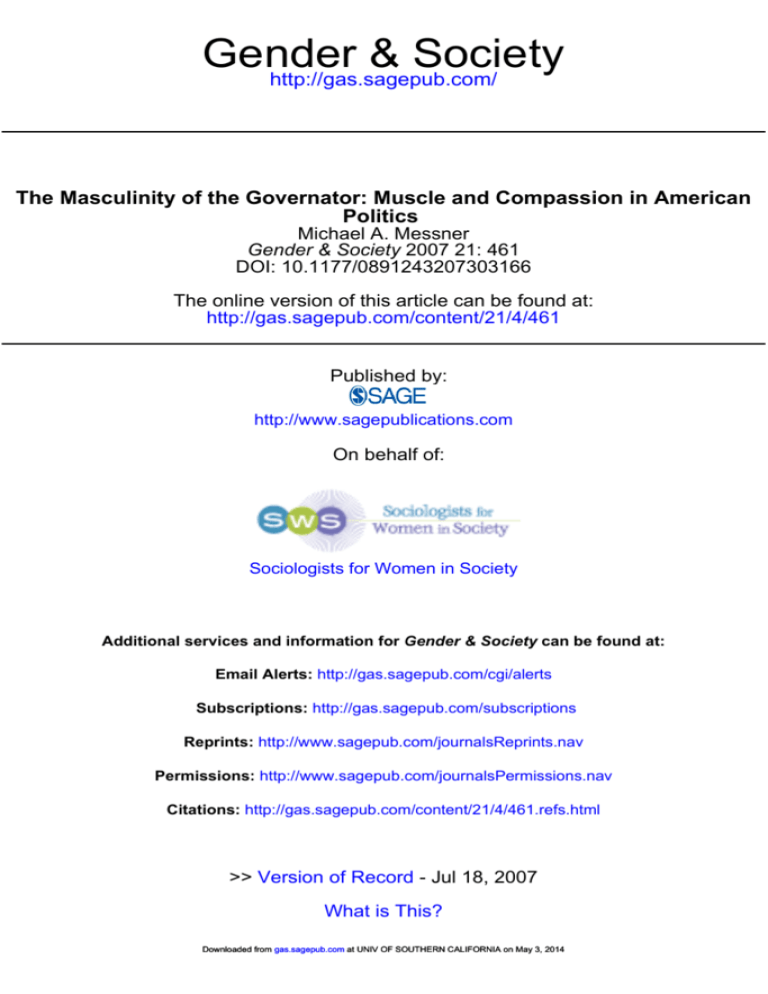
Gender & Society http://gas.sagepub.com/ The Masculinity of the Governator: Muscle and Compassion in American Politics Michael A. Messner Gender & Society 2007 21: 461 DOI: 10.1177/0891243207303166 The online version of this article can be found at: http://gas.sagepub.com/content/21/4/461 Published by: http://www.sagepublications.com On behalf of: Sociologists for Women in Society Additional services and information for Gender & Society can be found at: Email Alerts: http://gas.sagepub.com/cgi/alerts Subscriptions: http://gas.sagepub.com/subscriptions Reprints: http://www.sagepub.com/journalsReprints.nav Permissions: http://www.sagepub.com/journalsPermissions.nav Citations: http://gas.sagepub.com/content/21/4/461.refs.html >> Version of Record - Jul 18, 2007 What is This? Downloaded from gas.sagepub.com at UNIV OF SOUTHERN CALIFORNIA on May 3, 2014 Sociologists for Women in Society Feminist Lecture THE MASCULINITY OF THE GOVERNATOR Muscle and Compassion in American Politics MICHAEL A. MESSNER University of Southern California Arnold Schwarzenegger’s celebrity status allowed him to project a symbolic masculine persona that was effective in gaining political power as California governor. The well-known violent tough-guy persona that Schwarzenegger developed in the mid-1980s contributed to a post–Vietnam era cultural remasculinization of the American man. But this narrow hypermasculinity was often caricatured in popular culture and delegitimized. In the 1990s and 2000s, Schwarzenegger forged a credible masculine imagery by introducing characters who were humorously self-mocking and focused on care and protection of children. Schwarzenegger’s resultant hybrid masculinity, the “Kindergarten Commando,” represents an ascendant hegemonic masculinity always foregrounding muscle, toughness, and the threat of violence and following with situationally appropriate symbolic displays of compassion. The equation of toughness plus compassion composing the Kindergarten Commando is asymmetrical, with toughness eclipsing compassion; this has implications for the kinds of policies that U.S. elected leaders advocate. Republicans utilize this masculine imagery in national politics to gain voters’ trust in times of fear and insecurity and continue to employ a strategy that projects a devalued feminized stigma onto more liberal candidates. Keywords: masculinity; electoral politics; Arnold Schwarzenegger; gender and film T he big news story on November 7, 2006, was that voters had returned control of the U.S. Congress to the Democrats. This represented a dramatic turning of the electoral tide against the policies of Republican President George W. Bush—especially against his stubborn mantra to AUTHOR’S NOTE: Many thanks to the Sociologists for Women in Society (SWS) for honoring me as the Feminist Lecturer. I enjoyed meeting the faculty and students at the University of Maine and the New College of Florida, where I delivered the SWS lecture. Thanks to Ellexis Boyle, Shari Dworkin, Jeffrey Montez de Oca, and Kristen Barber for their helpful and supportive suggestions on an earlier version of this article and to Dana Britton for her helpful editorial work. GENDER & SOCIETY, Vol. 21 No. 4, August 2007 461-480 DOI: 10.1177/0891243207303166 © 2007 Sociologists for Women in Society 461 Downloaded from gas.sagepub.com at UNIV OF SOUTHERN CALIFORNIA on May 3, 2014 462 GENDER & SOCIETY / August 2007 “stay the course” in the war on Iraq. But apparently swimming against this tide was another story. On that same day, Republican Arnold Schwarzenegger was reelected as California governor by a landslide, winning 56 percent of the vote over Democratic challenger Phil Angelides’s mere 39 percent. During a year of resurgent Democratic strength nationally, in a solidly Democratic state, and only a year after his popularity had plummeted with voters, how do we explain Schwarzenegger’s resounding victory? In this article, I will explore this question by examining Schwarzenegger’s public masculine image. A key aspect of Schwarzenegger’s public image, of course, is his celebrity status, grounded first in his career as a world champion bodybuilder and even more so in his fame as one of the most successful action film stars of his generation (Boyle 2006). My aim here is not to analyze Arnold Schwarzenegger’s biography. Nor do I intend to offer a critical analysis of his films—I confess, I have watched some of them and not others (and I enjoy the ones that I have seen). Instead, my aim is both practical and theoretical: I will outline the beginnings of a cultural analysis of how and why Schwarzenegger rose to political power, what his appeal was and is, and how some current debates in gender theory might be useful in informing these questions. I will consider what Schwarzenegger’s deployment of a shifting configuration of masculine imagery tells us about the limits and possibilities in current U.S. electoral politics. And I will deploy the concept of “hegemonic masculinity” to suggest how Schwarzenegger’s case illustrates connections between the cultural politics of gender with those of race, class, and nation. In particular, I hope to show how, when symbolically deployed by an exemplar like Arnold Schwarzenegger, hegemonic masculinity is never an entirely stable, secure, finished product; rather, it is always shifting with changes in the social context. Hegemonic masculinity is hegemonic to the extent that it succeeds, at least temporarily, in serving as a symbolic nexus around which a significant level of public consent coalesces. But as with all moments of hegemony, this consent is situational, always potentially unstable, existing in a dynamic tension with opposition. MASCULINITIES AND POLITICS Since the late 1980s, sociologists have tended to agree that we need to think of masculinity not as a singular “male sex role” but as multiple, contextual and historically shifting configurations. At any given moment, a dominant—or hegemonic—form of masculinity exists in relation to other subordinated or marginalized forms of masculinity and in relation to various forms of femininity (Connell 1987). Very few men fully conform to Downloaded from gas.sagepub.com at UNIV OF SOUTHERN CALIFORNIA on May 3, 2014 Messner / THE MASCULINITY OF THE GOVERNATOR 463 hegemonic masculinity. In fact, it is nearly impossible for an individual man consistently to achieve and display the dominant conception of masculinity, and this is an important part of the psychological instability at the center of individual men’s sense of their own masculinity. Instead, a few men (real or imagined) are positioned as symbolic exemplars for a hegemonic masculinity that legitimizes the global subordination of women and ensures men’s access to privilege. What makes this masculinity hegemonic is not simply powerful men’s displays of power but also, crucially, less powerful men’s (and many women’s) consent and complicity with the institutions, social practices, and symbols that ensure some men’s privileges (Messner 2004). To adapt a term that is now popular in marketdriven bureaucracies, hegemonic masculinity requires a “buy-in” by subordinated and marginalized men, and by many women, if it is to succeed as a strategy of domination. Thus, the concept of hegemonic masculinity is most usefully deployed when we think of it not as something that an individual “has”—like big muscles, a large bank account, or an expensive car. But then, what is it? Where does it reside? Can we define it, or is it something about which we simply say, “I know it when I see it”? To ask these kinds of questions, we need to develop ways of thinking about gender that are global, both in the geographic and in the conceptual senses of the word. Here, I want to explore the ways that we can think about hegemonic masculinity as a symbolically displayed “exemplar” of manhood around which power coalesces—and, it is important to note, not just men’s power over women but also power in terms of race, class, and nation (Connell and Messerschmidt 2005). I will suggest that it is in the symbolic realm where an apparently coherent, seemingly stable hegemonic masculinity can be forged (Gomez-Barris and Gray 2006). We can track this symbolic masculinity as it reverberates into institutions—in the case of Arnold Schwarzenegger, into the realm of electoral politics—and we can see how hegemonic masculinity works in relation to what Collins (1990) calls a “matrix of domination,” structured by race, class, gender, and sexuality. TERMINATING THE FEMINIZED AMERICAN MAN Arnold Schwarzenegger began his public career as a world champion bodybuilder. Many people mark his starring role in the award winning 1977 documentary on bodybuilders, Pumping Iron, as his film debut. However, Schwarzenegger actually appeared in a few other television and B films roles before that, including a typecast role in the 1970 film Downloaded from gas.sagepub.com at UNIV OF SOUTHERN CALIFORNIA on May 3, 2014 464 GENDER & SOCIETY / August 2007 Hercules in New York. Schwarzenegger’s celebrity star rose rapidly in the early 1980s, with a series of films that featured his muscular body as the ultimate fighting machine: Conan: The Barbarian (1982), Conan: The Destroyer (1984), Red Sonja (1985), Commando (1985), and Predator (1987). Among these popular 1980s films, it is The Terminator (1984) that most firmly established Schwarzenegger as a major film star and as king of a particular genre. Conan, Commando, and the Terminator appear in the 1980s, at the same time that Rambo and other hard, man-as-weapon, man-as-machine images filled the nation’s screens. Susan Jeffords (1989) calls this cultural moment a “remasculinization of America,” when the idea of real men as decisive, strong, and courageous arose from the confusion and humiliation of the U.S. loss in the Vietnam war, and against the challenges of feminism and gay liberation. Jeffords’s analyses of popular Vietnam films are especially insightful. The major common theme in these films is the Vietnam veteran as victimized by his own government, the war, the Vietnamese, American protestors, and the women’s movement—all of which are portrayed as feminizing forces that have shamed and humiliated American men. Two factors were central to the symbolic remasculinization that followed: First, these film heroes of the 1980s were rugged individuals who stoically and rigidly stood up against bureaucrats who were undermining American power and pride with their indecisiveness and softness. Second, the muscular male body, often with massive weapons added as appendages, was the major symbolic expression of remasculinization. These men wasted very few words; instead, they spoke through explosive and decisively violent bodily actions. Jeffords argues that the male body-as-weapon serves as the ultimate spectacle and locus of masculine regeneration in post–Vietnam era films of the 1980s. There is a common moment in many of these films: The male hero is seemingly destroyed in an explosion of flames, and as his enemies laugh, he miraculously rises (in slow motion) from under water, firing his weapon and destroying the enemy. Drawing from Klaus Theweleit’s (1987) analysis of the “soldier-men” of Nazi Germany, Jeffords argues that this moment symbolizes a “purification through fire and rebirth through immersion in water” (Jeffords 1989, 130). During this historical moment of cultural remasculinization, Schwarzenegger was the right body at the right time. Muscular Arnold, as image, reaffirmed the idea of categorical sex difference in an era where such difference had been challenged on multiple levels. In this historical moment, the Terminator’s most famous sentence, “I’ll be back,” may have invoked an image of a remasculinized American Downloaded from gas.sagepub.com at UNIV OF SOUTHERN CALIFORNIA on May 3, 2014 Messner / THE MASCULINITY OF THE GOVERNATOR 465 man, “back” from the cultural feminization of the 1960s and 1970s, as well as a resurgence of American power in the world. It is possible to look at this remasculinized male subject in 1980s films as a symbolic configuration of hegemonic masculinity that restabilizes the centrality of men’s bodies and thus men’s (at least white U.S. men’s) power and privilege. Indeed, Messerschmidt’s (1993, 82) statement that “hegemonic masculinity . . . emphasizes practices toward authority, control, independence, competitive individualism, aggressiveness, and the capacity for violence,” seems to describe precisely the masculinity displayed by Schwarzenegger and Stallone in these 1980s films. But we need to be cautious about coming up with such a fixed definition of hegemonic masculinity. Although it clearly provided symbolic support for the resurgent conservatism of the Reagan era, this simplistic reversion to an atavistic symbology of violent, stoic, and muscular masculinity probably fueled tensions in gender relations as much as it stabilized them. As Connell and Messerschmidt (2005, 853) note, “gender relations are always arenas of tension. A given pattern of hegemonic masculinity is hegemonic to the extent that it provides a solution to these tensions, tending to stabilize patriarchal power or reconstitute it in new conditions. A pattern of practice (i.e., a version of masculinity) that provided such a solution in past conditions but not in new conditions is open to challenge—in fact is certain to be challenged.” There is plenty of evidence that by the end of the 1980s, the remasculinized muscular hero who wreaks havoc with his guns (biceps and bazookas) while keeping verbal expression down to a few grunts or occasional three-word sentences delivered in monotone was not playing well in Peoria. The 1988 final installment of Rambo (Rambo III) was listed by the 1990 Guinness Book of World Records as the most violent movie, with 221 acts of violence and more than 108 deaths. Despite (or because of?) this carnage, the film did not do well: Its gross in the United States was $10 million less than the film’s overall budget, and Stallone’s tired oneliners (Zaysen: “Who are you?” Rambo: “Your worst nightmare”) reportedly left audiences laughing derisively. Other icons of heroic masculine invulnerability tumbled from their pedestals: One of the actors who played the Marlboro man in cigarette ads died from lung cancer. By the late 1980s and early 1990s, the idea of men as invulnerable, nonemotional, working and fighting machines was frequently caricatured in popular culture and made fun of in everyday life. Health advocates grabbed onto this caricature with “culture jamming” counteradvertisements aimed at improving men’s health. For instance, a counterad distributed by the Downloaded from gas.sagepub.com at UNIV OF SOUTHERN CALIFORNIA on May 3, 2014 466 GENDER & SOCIETY / August 2007 California Department of Health Services referenced years of “Marlboro Country” ads by depicting two rugged cowboys riding side by side on their horses, with a caption that read, “Bob, I’ve got emphysema.” These sorts of ads invert the intended meanings of the Marlboro Man, illustrating how narrow cultural conceptions of masculinity are unhealthy—even deadly—for the men who try to live up to them. This new cultural sensibility is a direct legacy of the feminist critique of hypermasculinity. By the 1990s, these kinds of counterads could rely on readers to make the ironic connections, drawing on their own familiarity with the straight tobacco ads that were referenced, in addition to their familiarity with the increasingly prevalent cultural caricatures of hypermasculinity as dangerous, self-destructive, and (often) ridiculously laughable. THE BIRTH OF THE KINDERGARTEN COMMANDO Many professional-class white men in the 1980s and 1990s began to symbolically distance themselves from this discredited view of traditional masculinity and forged new, more sensitive forms of masculinity. But this is not to say that successful and powerful men have fully swung toward an embrace of femininity and vulnerability. Some men’s brief flirtations with soft, “new man” styles in the 1970s—the actor Alan Alda comes to mind—were thoroughly discredited and marginalized. Instead, we have seen the emergence of a symbology of masculinity that is hybrid: Toughness, decisiveness, and hardness are still central to hegemonic masculinity, but it is now normally linked with situationally appropriate moments of compassion and, sometimes, vulnerability. The 1980s and 1990s saw the increasingly common image of powerful men crying—not sobbing, but shedding a tear or two—in public: President Ronald Reagan in speaking of soldiers’ sacrifices after the 1983 U.S. invasion of Grenada, General Norman Schwartzkopf at a press conference noting U.S. troops killed during the 1990-1991 Gulf War, basketball player Michael Jordan in the immediate aftermath of winning his first NBA championship in 1991. These emotional displays may have been fully genuine, but I emphasize that they were not delivered in the aftermath of a loss, in a moment of vulnerability, failure, or humiliation. Try to imagine for a moment superstar NBA player Dirk Nowitzki, after the Dallas Mavericks’ 2006 loss in the NBA Finals, dropping to his knees at center court, overcome with grief, weeping openly with his face buried in his hands. That is not likely to happen. Tears are appropriate as public masculinity displays in the immediate aftermath of winning an NBA championship, or of having just successfully overrun a small Third World Downloaded from gas.sagepub.com at UNIV OF SOUTHERN CALIFORNIA on May 3, 2014 Messner / THE MASCULINITY OF THE GOVERNATOR 467 country with virtually no military. Powerful men have found it most safe to display public grief or compassion not in relation to their own failures or to the pain of other men—this might be perceived as weakness—and not in terms of women’s struggles for respect and equality—this might be perceived as being “pussywhipped” (a recently revived epithet in pop culture). Rather, the public compassion of this emergent masculinity is most often displayed as protective care—often for children—which brings us back to the Governator.1 Schwarzenegger’s original Terminator character was an unambiguously violent male-body-as-weapon, severed from any capacity for human compassion. But in the late 1980s, this image began to be rounded out by—not replaced with—a more compassionate persona. We can actually watch this transformation occur in Terminator II: Judgment Day (1991). In this film, Schwarzenegger, although still a killing machine, becomes the good guy, even showing occasional glimpses of human compassion. And significantly, it is his connection with a young boy that begins to humanize him. Taken together, Schwarzenegger’s films of the 1990s display a masculinity that oscillates between his more recognizable hard guy image and an image of self-mocking vulnerability, compassion, and care, especially care for kids (e.g., Kindergarten Cop, 1990; Jingle All the Way, 1996). I call this emergent hybrid masculinity “The Kindergarten Commando.” Indeed, in Schwarzenegger’s first major foray into California politics in 2002, he plugged his ballot initiative for after-school activities for kids by saying that he had been “an action hero for kids in the movies; now I want to be an action hero for kids in real life.” In the 1994 comedy Junior, Schwarzenegger appropriates an ultimate bodily sign of femaleness: pregnancy and childbirth. But Schwarzenegger’s gender hybridity could never be mistaken as an embrace of a 1970sstyled androgyny. Instead, in the Kindergarten Commando masculinity of Arnold Schwarzenegger, we see the appropriation and situational display of particular aspects of femininity, strategically relocated within a powerfully masculine male body. In his initial 2003 run for California governor, Schwarzenegger positioned himself as a centrist unifier, and his film-based masculine imagery supported the forging of this political image. Hardness and violence, plus compassion and care, is a potent equation for hegemonic masculinity in public symbology today. And what tethers these two seemingly opposed principles is protection—protection of children and women from bad guys, from evil robots from the past, or from faceless, violently irrational terrorists from outside our borders. Downloaded from gas.sagepub.com at UNIV OF SOUTHERN CALIFORNIA on May 3, 2014 468 GENDER & SOCIETY / August 2007 The post–9/11 world has provided an increasingly fertile ground for the ascent of the Kindergarten Commando as compassionate masculine protector. Iris Marion Young (2003) has argued that the emergent U.S. security state is founded on a renewed “logic of masculine protection.” And as Stephen Ducat (2004) has argued in his book The Wimp Factor, right-wing movements have seized this moment to activate a fear among men of “the mommy state”—a bureaucratic state that embodies weakness, softness, and feminist values. The desire for a revived “daddy state” is activated through a culture of fear: Only the man who really cares about us, and is also tough enough to stand up to evil, can be fully trusted to lead us in these dangerous times. The ascendance of this form of hegemonic masculinity is a response to feminist and other critiques of the limits of a 1950s John Wayne–style masculinity, and it thrives symbiotically with pervasive fears of threats by outsiders. This is not a symmetrical symbiosis, though: In a male political leader today, compassion and care seem always to be subordinated to toughness, strength, and a single-minded resolve that is too often called “decisiveness” but that might otherwise accurately be characterized as stubborn narrowmindedness. This asymmetry is reflected in Schwarzenegger’s recent films, in which the violent, tough-guy hero has never been eclipsed by the vulnerable kid-loving guy: in End of Days (1999), Schwarzenegger saves the world from no less a force of evil than Satan himself. The emergent Kindergarten Commando masculinity is forged within a post–9/11 context in Schwarzenegger’s 2002 film Collateral Damage. Here, Firefighter Gordon Brewer is plunged into the complex and dangerous world of international terrorism after he loses his wife and child in a terrorist bombing. Frustrated with the official investigation and haunted by the thought that the man responsible for murdering his family might never be brought to justice, Brewer takes matters into his own hands and tracks his quarry ultimately to Colombia. When Terminator III: Rise of the Machines hit the theatres in 2003, Schwarzenegger was running for governor of California. In T3, it was clear that the hero, though still an admirably efficient killing machine, had mobilized his human compassion to fight for humanity against the evil machines. HEGEMONIC MASCULINITY IN A MATRIX OF DOMINATION My argument thus far is that the currently ascendant hegemonic masculinity constructed through a combination of the film images of Arnold Schwarzenegger is neither the stoic, masculine, postwar hero image of Downloaded from gas.sagepub.com at UNIV OF SOUTHERN CALIFORNIA on May 3, 2014 Messner / THE MASCULINITY OF THE GOVERNATOR 469 John Wayne nor the 1980s remasculinized man-as-machine image of Rambo or the Terminator. These one-dimensional masculine images, by the 1990s, were laughable. Instead, the ascendant hegemonic masculinity combines the kick-ass muscular heroic male body with situationally expressive moments of empathy, grounded in care for kids and a capacity to make us all feel safe. Feminism, antiwar movements, health advocates, and even modern business human relations management have delegitimized pure hypermasculinity. But many people still view effeminacy as illegitimate in men, especially those who are leaders. So, neither hard nor soft is fully legitimate, unless the two are mixed, albeit with a much larger dose of the former than of the latter. And commercial interests have fruitfully taken up this hybrid masculine image: Heterosexual men, as we saw in the TV show Queer Eye for the Straight Guy, are seen as more attractive to women when softened—provided they still have power, muscles, and the money to purchase the correct draperies, fine cuisine, clothing, cosmetics, and other body-management products. Arnold, of course, has all of this. His masculinity displays were effective in securing power. But toward what ends? What do we see in the play of hard and soft, in strength and compassion in terms of what he does as governor? Three events are very revealing, and I will discuss them very briefly: first, the governor’s playfully aggressive use of references to his film and bodybuilder careers in his ongoing budget battles with the Democrats; second, his class politics—particularly in his dealings with business and labor interests in California; and third, the “woman problem” that emerged during his first election. Girlie Men and Political Intertextuality During his earliest days in office, Schwarzenegger famously mobilized the “girlie men” epithet and turned it on his Democratic opponents in the California legislature. In doing so, he deployed references to his own Terminator films (urging voters to “terminate” his democratic opponents), and the “girlie men” comments referenced the Saturday Night Live skit that had originally spoofed him. This illustrates the often-noted fact that cultural symbols do not float free: They emerge from and in turn enter into social relations. Schwarzenegger strategically deployed the imagery of the Kindergarten Commando to get himself elected. But in the real life of governing, when push came to shove, he fell back on the Terminator, not the lovable Kindergarten Cop protector of children, as a strategy for deploying power. Schwarzenegger’s girlie man taunt is not the first time that a politician has drawn from popular commercial culture to invoke an image aimed to Downloaded from gas.sagepub.com at UNIV OF SOUTHERN CALIFORNIA on May 3, 2014 470 GENDER & SOCIETY / August 2007 undermine his opponents. Recall, for instance, then vice president Walter Mondale’s 1984 attempt to attack his Republican presidential race opponent’s lack of substantive ideas by humorously deploying a “where’s the beef?” chant that referenced the then-popular Wendy’s hamburger commercial. However, by comparison, Schwarzenegger’s girlie man insult is a rather unprecedented multilevel image: It is a veritable Möbius strip of meanings, with life imitating ironic schlock, imitating life, imitating more schlock. Audiences get a sense of pleasure and power—a sense of authorship— from being insiders as they participate in decoding familiar intertextual messages such as “where’s the beef?” “girlie man,” or “I’ll be back!” And if we think of the electorate as an audience (and certainly political parties use all the advertising expertise that they can muster), an election can be seen as a sort of poll of the audience’s preferences. The electorate is buying a particular candidate who has been sold to them. Schwarzenegger’s reference to girlie men and to The Terminator appealed to his supporters, but it also set off a firestorm of criticism from feminists, gay/lesbian organizations, and Democratic legislators. The governor’s plea to voters to “terminate” his Democratic foes in November not only disrupted his thusfar carefully crafted image of the bipartisan get-it-done compromiser but also indicated the reemergence of a gloves-off muscular masculinity behind which the kind and compassionate Kindergarten Cop receded into the background. And this spelled some trouble for the Governator. The symbolic symmetry of the new man—the Kindergarten Commando—was broken, leaving Schwarzenegger once again vulnerable both to sarcastic media caricature and to open questioning about the misogyny and homophobia that might lie behind the warm smile. However, the fact that Schwarzenegger’s power was anchored so much in the symbolic realm facilitated his ability to deploy his power in a form that allowed for humorous, ironic interpretation; the implied self-mocking in his girlie man comments gets him off the hook, perhaps, from otherwise coming across as a bully: Democrats who decry the sexism or homophobia embedded in the girly man comment appear perhaps to have no sense of humor. In the vernacular of the shock radio so popular with many young white males today, people who object to Schwarzenegger’s comments as sexist or homophobic are “feminazis”; they just don’t get the joke (Benwell 2004; Messner and Montez de Oca 2005). Hegemonic Masculinity and Class Politics Meanwhile, though, it is clear that the joke was on some of the most vulnerable people of California. My second example concerns Schwarzenegger’s Downloaded from gas.sagepub.com at UNIV OF SOUTHERN CALIFORNIA on May 3, 2014 Messner / THE MASCULINITY OF THE GOVERNATOR 471 class politics. In August 2004, he vetoed a minimum wage increase. Simultaneously, he supported Walmart’s economic colonization of the California retail industry. Walmart’s importation of notoriously lowwaged jobs has been resisted by organized retail unions and by several California cities and towns, yet it was clear which side Schwarzenegger took in this struggle. This illustrates how hegemonic masculinity enters class relations: If there was compassion here, it was compassion for big business; if there was muscle to be deployed, it was against the collective interests of working people, defined by the governor’s business logic as special interests. Governor Schwarzenegger also attacked public employees’ unions in his effort to control state spending. A National Public Radio story on March 15, 2005 noted that members of the California Nurses Association were showing up and protesting in every public venue in which he appeared. As he was giving a speech to supporters, one could hear the voices of the nurses chanting something in the background. Schwarzenegger commented to a cheering crowd, “Pay no attention to them. They are the Special Interests. They don’t like me in Sacramento, because I am always kicking their butts!” Indeed, earlier that year, Schwarzenegger had vetoed the rule that mandated a lower nurse/doctor ratio and also took $350,000 in campaign contributions from pharmaceutical companies while opposing a prescription drugs law that would have helped consumers. His proposed 2005 budget included cuts in welfare, cuts in dental aid for the poor, cuts in the state’s contribution to caregivers for the disabled and the elderly, and a scaling back of retirement plans for state workers. By 2005, children in the California public schools had good reason to suspect that the protective Kindergarten Commando had morphed into the Kindergarten Terminator. Despite a previous promise not to cut education spending, his proposed budget included $2.2 billion in education cuts while holding firm on his promise not to raise taxes. The ideological basis of these class politics—and their links to the politics of race and immigration—was further demonstrated in Schwarzenegger’s speech at the 2004 Republican National Convention. Here, he told his own rugged individualist immigrant story, with clear pull-yourself-up-by-yourbootstraps, Horatio Alger themes. While positioning himself on the surface as someone who cares about and understands immigrants, his story reiterated conservative themes that are grounded in the experience of white ethnics rather than in that of the vast majority of California’s current immigrant population who deal daily with poverty, institutionalized racism, and escalating Downloaded from gas.sagepub.com at UNIV OF SOUTHERN CALIFORNIA on May 3, 2014 472 GENDER & SOCIETY / August 2007 xenophobia. Schwarzenegger’s narrative thus helps to reconstruct a white male subject and demonstrates how hegemonic masculinity is never just about gender: It is also about race and nation (Montez de Oca 2005). Hegemonic Masculinity as Heterosexy My third example concerns Schwarzenegger’s woman problem. During the final weeks of the 2003 election, the Los Angeles Times broke a series of stories indicating that several women had complained of Schwarzenegger’s having sexually harassed and humiliated them in various ways over the years. The women’s claims were quickly trivialized by being more benignly defined as “unwanted groping.” Ironically, these accusations probably enhanced Schwarzenegger’s status with many men and may have helped to secure the complicity of many women, as evidenced by the “Arnold, Grope Me!” signs seen at some of his rallies in the final days of his run for governor. Here, we can see that the hegemonic masculinity created by Schwarzenegger’s symbolic fusing of opposites also involves the construction of a particular form of masculine heterosexuality. We should not underestimate the extent to which the imagery of hegemonic masculinity is electrified with an erotic charge—a charge that serves as a powerful linking process in constructing dominant forms of femininity—and through that, the consent of many women. In fact, it is likely that while the groping charges solidified an already-existing opposition to Schwarzenegger, they also pulled some voters more solidly into his camp. A comparison with former president Bill Clinton is useful in this regard. Stephen Ducat (2004) discusses how during his first term as president, Clinton was vulnerable to questions about his masculinity due to his lack of military service, his support for women’s and gay issues, and especially the perception that his wife Hillary “wore the pants” in his family. Clinton, according to Ducat, lacked symbolic ownership of the phallus, necessary for a man with power. Attempts by Clinton’s handlers to symbolically masculinize Bill and to feminize Hillary did little to help either of their images. However, in the aftermath of the scandals surrounding Bill Clinton’s sexual relations with White House intern Monica Lewinsky, Clinton’s poll numbers skyrocketed. A 1998 Gallup poll conducted after the scandal broke found that Americans saw him as the most admired man in the world. He had morphed, in Ducat’s (2004) words, from “emasculated househusband to stud muffin,” from “pussy” to “walking erection.” Hillary Clinton’s “stand by your man” posture apparently enhanced her popularity, too. Downloaded from gas.sagepub.com at UNIV OF SOUTHERN CALIFORNIA on May 3, 2014 Messner / THE MASCULINITY OF THE GOVERNATOR 473 As governor, Schwarzenegger’s virile sexual image has been stabilized in large part by his famous Democratic wife Maria Schriver’s steadfastly supportive presence. The story of his past sexual indiscretions was quickly dropped by the media, apparently seen as (1) just another example of a woman (in this case almost a dozen separate women!) trying to bring down a powerful man with a sex scandal, or (2) an example of certain sexual conventions being acceptable in one context (Hollywood) and not in others, and/or (3) something that, while regrettable, is now all in the past, perhaps like Schwarzenegger’s past statements of admiration for Adolph Hitler. HEGEMONIC MASCULINITY AND WOMEN IN POLITICS To summarize, Arnold Schwarzenegger’s sexy, hybrid mix of hardness and compassion is currently a configuration of symbols that forge a masculinity that is useful for securing power among men who already have it. But for a woman striving for power—at least in the context of the United States’s current gender order—these opposites do not mesh as easily. Strength and compassion, when embodied in a woman leader, still appear to clash in ways that set her up for public crucifixion: U.S. Congresswoman Pat Schroeder’s brief flirtation with a presidential run in 1988—derailed by a public tear—comes to mind. Although Schroeder’s many successful years in Congress, and especially her position as head of the Congressional Armed Services Committee, might have made her seem a serious candidate for the presidency, one public tear made her seem perhaps too feminine to become president. By contrast, during her years as first lady, Hillary Clinton was pilloried for her supposed ballbusting of her husband and for having her own ambitions to gain political power—in short, for being too much like a man. Former British prime minister Margaret Thatcher is no exception; she proves the rule. Thatcher was notoriously conservative with respect to slashing the British welfare state, and she complemented then U.S. president Ronald Reagan with her militaristic saber rattling. An individual woman can occasionally out-masculine the men and be a strong leader. But as with Thatcher, she had better leave compassion and caring for the poor, for the sick, and for the aged literally at home. That is why I have been predicting for some time that our first woman president, or vice president, will be a Republican. To be seen as a credible candidate, a woman candidate might downplay the politics of compassion and care and instead present herself as an advocate for, and leader of, the daddy state. Downloaded from gas.sagepub.com at UNIV OF SOUTHERN CALIFORNIA on May 3, 2014 474 GENDER & SOCIETY / August 2007 The Dangers of a Compassionate Masculinity Arnold Schwarzenegger is not the first male politician to attempt to craft a postfeminist hybrid symbology of hegemonic masculinity. George Bush Sr. battled his own reputation as a bureaucratic wimp with a masculinizing project of waging war against Saddam Hussein. He signaled his compassionate side with speeches encouraging others (instead of the government) to be “a thousand points of light” to help the poor and homeless. And the 2004 presidential election between Kerry and Bush seemed to devolve into another old Saturday Night Live satire: Quien es mas macho? This reveals something important about the ascendant hegemonic masculinity: It did not seem to matter to many voters that Bush had been a lousy student who partied his youth away and only escaped the shame of a drunk driving conviction, Vietnam War service evasion, and possible desertion from his National Guard service through his born-with-a-silver-spoon family connections. Nor did it seem to matter to many voters that John Kerry had served willingly in Vietnam and had been honored for bravery and war wounds. Kerry was still—with enough success to neutralize this apparent war hero advantage— stained by his association with elite liberalism. This is nothing new. Adlai Stevenson’s unsuccessful runs for the presidency in 1952 and 1956 offer a good case in point. The conservative attack on Stevenson can be seen as part of the postwar hysteria about reds and homosexuals. Kimmel (1996, 237) notes, “Not only was Stevenson labeled ‘soft’ on communism, but he was the classic ‘egghead.’ The candidate whom the New York Daily News called ‘Adelaide’ used ‘tea cup words,’ which he ‘trilled’ with his ‘fruity’ voice, and was supported by ‘Harvard lace cuff liberals’ and ‘lace panty diplomats.’” A month before the 1952 Democratic Convention, FBI head J. Edgar Hoover ordered a “blind memorandum” be prepared on Stevenson. The “investigation” concluded that Stevenson was “one of the best known homosexuals” in Illinois (Theoharis 2002, 180). Although the FBI memorandum was not made public at the time, attacks on Stevenson’s masculinity (linked with his liberalism and intellectualism) formed a core of the contrast that Republicans successfully drew between Stevenson and war hero General Dwight D. Eisenhower, who handily won the election—and reelection four years later. For the past half century, conservatives have used a version of this same gender strategy to wage a successful symbolic campaign that links liberalism with softness: Book learning and intellectual curiosity are viewed as a lack of inner strength and determination. Seeing the complications and gray areas in any public debate is viewed as a sign of Downloaded from gas.sagepub.com at UNIV OF SOUTHERN CALIFORNIA on May 3, 2014 Messner / THE MASCULINITY OF THE GOVERNATOR 475 waffling and a lack of an inner values-based compass. And compassion for the pain of others is seen as weakness. To be sure, as President George W. Bush’s slogan about “compassionate conservatism” showed, conservatives have incorporated the language of care into their project. As I have argued, a leadership masculinity without compassion is now symbolically untenable. But the new hybrid hegemonic masculinity always leads with the muscle. Muscle must first and foremost be evident; compassion is displayed at appropriate symbolic moments, suggesting a human side to the man. Liberalism suffers from the fact that it seems too often to lead with compassion, not with muscle. So when liberals try to look muscular, they are much more easily subjected to ridicule, like they are in some sort of gender drag, as evidenced by the infamous moment when 1988 democratic presidential candidate Michael Dukakis tried to dress up like a commander-in-chief but ended up looking more like a schoolboy taking a joyride in a tank while wearing a too-large military costume. George W. Bush’s love of military dress-up did not draw the same kind of ridicule. Or at least it can be said that this kind of ridicule does not seem to stick in the way it does when aimed at a supposed liberal. And so, very sadly I think, in recent presidential campaigns, we saw both candidates trying their hardest to appear tough, strong, decisive, athletic, and militaristic, while suggesting—parenthetically, almost as an afterthought—that they care about all of us, that seniors should get prescription drugs, that no child should be left behind. The asymmetries in the ways that these two candidates were able to deploy this hybrid masculinity were apparent: When Kerry said that smart leadership would lead to a “more sensitive” waging of the war in Iraq, it was the only opening that any manly hunter would need: Vice President Dick Cheney needed no shotgun to jump right on this opportunity to blast the war hero with the feminized symbolism of weakness and liberalism. GENDER, POLITICS, AND JUSTICE The accomplishment of a stable hegemonic masculinity by an individual man in daily interactions is nearly impossible. But what helps to anchor an otherwise unstable hegemonic masculinity is the play of masculine imagery in the symbolic realm. Today, for the moment, the gender imagery seen in the combined films of Arnold Schwarzenegger creates a hybrid masculinity I am calling the Kindergarten Commando. This image, Downloaded from gas.sagepub.com at UNIV OF SOUTHERN CALIFORNIA on May 3, 2014 476 GENDER & SOCIETY / August 2007 when deployed in the realm of electoral politics, secures power and privilege in a moment of destabilized gender and race relations, economic insecurity, and concerns about immigration, all permeated with a culture of fear. The widespread consent that accumulates around this form of masculinity is, I suggest, an example of hegemony at work. And—it is important to note—the power and privilege that this hegemonic masculinity secures is not necessarily or simply men’s power over women. The erotically charged masculinity of the famously cigar-loving Governator was effective in securing power in terms of race and nation, and in class relations in California. What I am suggesting here is that the public symbolism of hegemonic masculinity is a means of consolidating power in a matrix of class, race, and international politics. For California in 2004, it was Arnold Schwarzenegger’s combination of muscle, heterosexuality, and whiteness— particularly the way his story reiterated the white European melting pot story of individualism and upward mobility in a meritocratic America—that formed a successful symbolic package that enough voters liked. As governor, Schwarzenegger mobilized this package first and foremost to wage class war on California’s public workers and poor. But as Connell and Messerschmidt (2005) point out, hegemonic masculinity is always contingent and contextual. As contexts change, challenges are possible, perhaps inevitable. And California during the past few years has certainly been a site of rapid shifts and conflicts. Schwarzenegger’s attack on the underprivileged left him open to criticism of his own privilege and the possible use of his office to further his own interests. Opposition to Schwarzenegger mounted in 2005, as organized California teachers, nurses, firefighters, and other public employees waged massive protests and media campaigns against the governor. His having flexed his Terminator muscles left him open to questioning about whether he really cared about the elderly. Health activists and advocates for the elderly railed at the large donations he had accepted from the insurance and pharmaceutical industries and his decisions that reflected those links. Perhaps, at least in California, a less conservative state than most, many of the governor’s constituents wanted to see care and compassion reflected in actual policies rather than simply in some of his movies. And so, after the ballot initiatives that he had sponsored were soundly defeated in the 2005 special election that he had called for, Schwarzenegger immediately shifted his strategy, leaving his combative Terminator persona behind and returning to the Kindergarten Commando. He began to promote some liberal issues, including signing landmark legislation to control global warming. He finally agreed to sign legislation to authorize a Downloaded from gas.sagepub.com at UNIV OF SOUTHERN CALIFORNIA on May 3, 2014 Messner / THE MASCULINITY OF THE GOVERNATOR 477 modest raise in California’s minimum wage. But he also advocated cutting thousands of poor off of the welfare rolls and continued his ties with corporate elites in the pharmaceutical industry. Perhaps the new model for Schwarzenegger might be closer to the masculinity of Bill Clinton— combining a moderate liberalism on social issues like women’s and gay rights with a fiscal conservatism that continues to enlarge the gap between rich and poor. The success of this new man leadership style is at once a visible sign of the ways that liberal feminist critiques of hypermasculinity have been incorporated and embodied into many professional-class men’s interactional styles and displays. What results is a rounding of the hard edges off of hypermasculinity and a visible softening of powerful men’s public styles and displays. But this should not be seen necessarily as a major victory for feminism. Rather, if I am correct that this more sensitive, new man style tends to facilitate and legitimize privileged men’s wielding of power over others, this is probably better seen as an example of feminism’s being co-opted into new forms of domination—in this case, class and race domination. Schwarzenegger’s return to Kindergarten Commando masculinity appears to have worked. His shift to more centrist stands—undoubtedly influenced by his more liberal wife, Maria Schriver—has calmed the antiArnold storms of 2005. And clearly, the muscle still matters: One of the largest advantages he had over his Democratic opponent in 2006 was that voters saw Schwarzenegger as a much stronger leader. A preelection poll conducted by the Los Angeles Times found that 60 percent of likely voters saw Schwarzenegger as a “strong leader” while only 20 percent viewed Phil Angelides as strong. In short, I speculate that Governor Schwarzenegger’s 2004-2005 rejection of the hybrid Kindergarten Commando masculine imagery that had gotten him elected contributed to a dramatic decline in his popularity and to his thrashing in the special election of 2005. When he dropped the oppositional tough-guy approach, and redeployed the Kindergarten Commando, his popularity again soared in 2006, contributing to his landslide reelection. CONCLUSION If we are to work toward economic justice for working people, immigrants, and the aged; equality for women and racial and sexual minorities; and the creation of a more just and peaceful world, we need to tackle Downloaded from gas.sagepub.com at UNIV OF SOUTHERN CALIFORNIA on May 3, 2014 478 GENDER & SOCIETY / August 2007 head-on the ways that dominant forms of masculinity—while always contested and shifting—continue to serve as a nexus of power that secures the privileges of the few at the expense of the many. Governor Arnold Schwarzenegger’s strategic shifting of his public persona from Kindergarten Commando to Terminator and then back to Kindergarten Commando illustrates how, in the realm of electoral politics, hegemonic masculinity is a malleable symbolic strategy for wielding power. In electoral politics, men’s militaristic muscular posturing in seeking office limits women’s abilities to seek high office in much the same ways that narrow masculine displays of dress, demeanor, voice, and style narrow women’s chances in corporate or professional occupations. Women’s activism in public life challenges these limitations, but if meaningful change is to occur, men leaders must also stop conforming to a singular masculine style of dress, demeanor, or leadership style. When men create a wider range of alternative masculine styles of leadership, it opens space for women (and for other kinds of men). Ironically, Arnold Schwarzenegger is perfectly positioned in 2007 and beyond to model a different kind of masculinity and a different kind of leadership. The social and political context of California (and perhaps his more liberal wife) have already pushed him to the Left—even to the point where by early 2007, members of his own party had begun to complain that he, in effect, had become a Democrat. And Schwarzenegger’s public image has softened, partly in response to several widely distributed photos of him on a beach, showing a flabby middle, sagging pectoral muscles, and arms far thinner than the guns he proudly displayed in his bodybuilding and film careers. Schwarzenegger is aging; he attended his own inauguration on crutches in the aftermath of a skiing injury. The mass media are reporting that he is depressed by the decline of his own body and is speculating that his health problems may be related to his earlier use of steroids. Although this creates a potential opportunity for Schwarzenegger, it would be foolhardy for anyone to look hopefully to him to create a counterhegemonic gender symbolism. In fact, it is unlikely that new, expansive, and progressive imagery will emanate from top male politicians. It is more likely that some men who seek high office but have progressive (even feminist) values may try to be “stealth feminists”—while posturing in military garb (Dukakis in 1988), downplaying a deep commitment to reversing the human destruction of the environment (Gore in 2000), or overemphasizing long past military accomplishments (Kerry in 2004) instead of focusing on issues and values that they cherish. This does not work, partly because it is bad theatre. Even if this strategy succeeds in getting someone elected, it is unlikely that stealth feminism will work; men who get to the top using masculine Downloaded from gas.sagepub.com at UNIV OF SOUTHERN CALIFORNIA on May 3, 2014 Messner / THE MASCULINITY OF THE GOVERNATOR 479 muscle will rightly assume that once in office, their constituents expect them to flex those muscles (e.g., President Jimmy Carter’s ill-fated use of military power in 1980 in his attempt to end the Iran hostage crisis). Are there alternatives? Think of former president Jimmy Carter, and more recently former vice president Al Gore in their postelectoral politics lives. They have both done brave and important work, work grounded in compassion for peoples of the world, for peace, and for the environment. When I reflect on their failures in electoral politics, I cannot help but wonder if this is a case of the clothes not having fit the men. Clearly, instead of the man (or the woman) having to adopt a ridiculous drag to be taken seriously as a leader, or as a potential leader, we need to change the clothes of politics so that they better suit the kinds of leaders we need: smart, literate, visionary, compassionate leaders who shape and fight for policies that help everyday people, not just here in the United States but globally. Carter and Gore have found roles that suit them, postpolitics, and have done good work. But we cannot accept it as good enough that national leaders can live out their compassionate and progressive values only after leaving national office. There must be alternatives. What we need is a renewed movement of ordinary women and men working side by side to push assertively for an ideal of the public that is founded first and foremost on compassion and caring. The seeds of such a movement currently exist—in feminist organizations, in the peace movement, in religious-based immigrant rights organizations, in unionbased organizing for the rights of workers. A coalition of these progressive organizations can succeed in infusing local and national politics with the values of public compassion. This will not happen easily, or without opposition. We need to expect that such a movement will have to be tough and will have to fight—against entrenched privilege and against the politics of fear—to place compassion and care at the top of the public agenda. Out of such a movement, we can generate and support women and men who will lead with love and compassion and follow with the muscle. NOTE 1. The term “Governator” became a widely used way to refer to Arnold Schwarzenegger in the popular media and among Californians in the aftermath of his election as California governor. The term symbolically links his job as governor with his best-known film role in The Terminator and speaks to the successful construction of a hybrid celebrity personality that I discuss in this article. Downloaded from gas.sagepub.com at UNIV OF SOUTHERN CALIFORNIA on May 3, 2014 480 GENDER & SOCIETY / August 2007 REFERENCES Benwell, Bethan. 2004. Ironic discourse: Evasive masculinity in men’s lifestyle magazines. Men and Masculinities 7:3-21. Boyle, Ellexis. 2006. Memorializing muscle in the auto/biography(ies) of Arnold Schwarzenegger. Paper presented at the annual meetings of the North American Society for the Sociology of Sport, Vancouver, BC, Canada, November 4. Collins, Patricia Hill. 1990. Black feminist thought: Knowledge, consciousness, and the politics of empowerment. Boston: Unwin Hyman. Connell, R. W. 1987. Gender & power. Stanford, CA: Stanford University Press. Connell, R. W., and James W. Messerschmidt 2005. Hegemonic masculinity: Rethinking the concept. Gender & Society 19:829-59. Ducat, Stephen J. 2004. The wimp factor: Gender gaps, holy wars, and the politics of anxious masculinity. Boston: Beacon. Gomez-Barris, Macarena, and Herman Gray. 2006. Michael Jackson, television and post-op disasters. Television and New Media 7:40-51. Jeffords, Susan. 1989. The remasculinization of America: Gender and the Vietnam War. Bloomington: Indiana University Press. Kimmel, Michael. 1996. Manhood in America: A cultural history. New York: Free Press. Messerschmidt, James. 1993. Masculinities and crime. Lanham, MD: Rowman & Littlefield. Messner, Michael A. 2004. On patriarchs and losers: Rethinking men’s interests. Berkeley Journal of Sociology 48:76-88. Messner, Michael A., and Jeffrey Montez de Oca. 2005. The male consumer as loser: Beer and liquor ads in mega sports media events. Signs: Journal of Women in Culture and Society 30:1879-1909. Montez de Oca, Jeffrey. 2005. “As our muscles get softer, our missile race becomes harder”: Cultural citizenship and the muscle gap. Journal of Historical Sociology 18:145-71. Theoharis, Athan. 2002. Chasing spies. Chicago: Ivan R. Dee. Theweleit, Klaus. 1987. Male fantasies. Vol. 1, Women, floods, bodies, history. Minneapolis: University of Minnesota Press. Young, Iris Marion. 2003. The logic of masculinist protection: Reflections on the current security state. Signs: Journal of Women in Culture and Society 29:1-25. Michael A. Messner is a professor of sociology and gender studies at the University of Southern California. He is the author of Taking the Field: Women, Men and Sports (2002) and Out of Play: Critical Essays on Gender and Sport (2007). Downloaded from gas.sagepub.com at UNIV OF SOUTHERN CALIFORNIA on May 3, 2014
